Towards Environmental Sustainability: Wastewater Management and Sewer Networks for Protecting Groundwater in Rural Settlements
Abstract
:1. Introduction
2. Materials and Methods
2.1. Location of the Study Area
2.2. Wastewater Agglomeration
2.3. Impacts of Uninsulated Septic Tanks on Groundwater
2.4. Field Measurements and Laboratory Analysis
2.5. Data Processing
3. Results and Discussion
3.1. Sewer Network Establishment in the Municipality
3.2. Impacts of Uninsulated Septic Tanks on Groundwater and Sewer Network Construction
3.3. Groundwater Contamination Around the Septic Tank and Changes After Its Elimination
3.4. Groundwater Level Changes in the Municipality After the Sewer Network Construction
4. Discussion
5. Conclusions
Author Contributions
Funding
Data Availability Statement
Acknowledgments
Conflicts of Interest
References
- Sharma, K.; Rajan, S.; Nayak, S.K. Chapter 1—Water Pollution: Primary Sources and Associated Human Health Hazards with Special Emphasis on Rural Areas. In Water Resources Management for Rural Development; Madhav, S., Srivastav, A.L., Chibueze Izah, S., van Hullebusch, E., Eds.; Elsevier: Amsterdam, The Netherlands, 2024; pp. 3–14. ISBN 978-0-443-18778-0. [Google Scholar]
- Zuniga-Teran, A.A.; Mussetta, P.C.; Lutz Ley, A.N.; Díaz-Caravantes, R.E.; Gerlak, A.K. Analyzing Water Policy Impacts on Vulnerability: Cases across the Rural-Urban Continuum in the Arid Americas. Environ. Dev. 2021, 38, 100552. [Google Scholar] [CrossRef]
- Makanda, K.; Nzama, S.; Kanyerere, T. Assessing the Role of Water Resources Protection Practice for Sustainable Water Resources Management: A Review. Water 2022, 14, 3153. [Google Scholar] [CrossRef]
- Sun, Q.; Yang, K.; Li, C.; Li, C.; Ling, X.; Yang, D. Analysis on the Chemical Characteristics and Genesis of Drinking Groundwater in Rural Areas of Suihua City, Northeast China. Environ. Forensics 2024, 25, 614–625. [Google Scholar] [CrossRef]
- Guo, W.; Li, P.; Du, Q.; Zhou, Y.; Xu, D.; Zhang, Z. Hydrogeochemical Processes Regulating the Groundwater Geochemistry and Human Health Risk of Groundwater in the Rural Areas of the Wei River Basin, China. Expo. Health 2024, 16, 291–306. [Google Scholar] [CrossRef]
- Sun, Q.; Guo, L.; Hu, C.; Liu, T.; Sun, J.; Zhou, L. Health Risk Assessment of Drinking Groundwater in Rural Areas of Ru Village and Surrounding Areas in Wutai County, China. J. Water Health 2023, 22, 183–196. [Google Scholar] [CrossRef]
- Kim, M.; Koh, E.-H.; Kim, J. Field Study and Numerical Modeling to Assess the Impact of On-Site Septic Systems on Groundwater Quality of Jeju Island, South Korea. Hydrology 2024, 11, 146. [Google Scholar] [CrossRef]
- WHO. Sanitation. Available online: https://www.who.int/news-room/fact-sheets/detail/sanitation (accessed on 21 January 2025).
- Alam, S.M.K.; Li, P.; Fida, M. Groundwater Nitrate Pollution Due to Excessive Use of N-Fertilizers in Rural Areas of Bangladesh: Pollution Status, Health Risk, Source Contribution, and Future Impacts. Expo. Health 2024, 16, 159–182. [Google Scholar] [CrossRef]
- Mester, T.; Szabó, G.; Kiss, E.; Balla, D. Long-Term Spatiotemporal Changes in Nitrate Contamination of Municipal Groundwater Resources after Sewerage Network Construction in the Hungarian Great Plain. Environ. Sci. Pollut. Res. 2024, 31, 61114–61137. [Google Scholar] [CrossRef]
- Abanyie, S.K.; Amuah, E.E.Y.; Douti, N.B.; Antwi, M.N.; Fei-Baffoe, B.; Amadu, C.C. Sanitation and Waste Management Practices and Possible Implications on Groundwater Quality in Peri-urban Areas, Doba and Nayagenia, Northeastern Ghana. Environ. Chall. 2022, 8, 100546. [Google Scholar] [CrossRef]
- UN Habitat; WHO. Progress on Wastewater Treatment—Global Status and Acceleration Needs for SDG Indicator 6.3.1; United Nations Human Settlements Programme (UN-Habitat) and World Health Organization (WHO): Geneva, Switzerland, 2021. [Google Scholar]
- Mester, T.; Szabó, G.; Sajtos, Z.; Baranyai, E.; Kiss, E.; Balla, D. Assessment of Groundwater Decontamination Processes around a Dismantled Septic Tank Using GIS and Statistical Analysis. Water 2023, 15, 884. [Google Scholar] [CrossRef]
- Shaban, J.; Al-Najar, H.; Kocadal, K.; Almghari, K.; Saygi, S. The Effect of Nitrate-Contaminated Drinking Water and Vegetables on the Prevalence of Acquired Methemoglobinemia in Beit Lahia City in Palestine. Water 2023, 15, 1989. [Google Scholar] [CrossRef]
- Nabi, A.; Garai, S.; Mondal, P.; Pal, F.; Ghosh, S.; Pal, P. Effect of Nitrate Contamination in Groundwater—A Worldwide Concern. J. Surv. Fish. Sci. 2023, 10, 6493–6497. [Google Scholar] [CrossRef]
- Istenic, D.; Bodík, I.; Bulc, T. Status of Decentralised Wastewater Treatment Systems and Barriers for Implementation of Nature-Based Systems in Central and Eastern Europe. Environ. Sci. Pollut. Res. 2015, 22, 12879–12884. [Google Scholar] [CrossRef] [PubMed]
- Vale, G.B.; Scalize, P.S.; Tonetti, A.L.; Ruggeri Junior, H.C. Cost-Effectiveness Study of Septic Tank Management in Rural Communities. Int. J. Environ. Sci. Technol. 2024, 21, 4599–4610. [Google Scholar] [CrossRef]
- Samadi, M.T.; Asgari, G.; Leili, M.; Chavoshi, S. Integrated Modified Septic Tank and Constructed Wetland: An Alternative Green Technology for Phytoremediation of Highly Polluted Leachate. Biomass Conv. Bioref. 2024, 14, 23761–23773. [Google Scholar] [CrossRef]
- Karczmarczyk, A.; Bus, A.; Baryła, A. Assessment of the Efficiency, Environmental and Economic Effects of Compact Type On-Site Wastewater Treatment Plants—Results from Random Testing. Sustainability 2021, 13, 982. [Google Scholar] [CrossRef]
- Vazquez-Montiel, O.; Horan, N.J.; Mara, D.D. Management of Domestic Wastewater for Reuse in Irrigation. Water Sci. Technol. 1996, 33, 355–362. [Google Scholar] [CrossRef]
- Gatto D’andrea, M.L.; Salas Barboza, A.G.J.; Garces, V.; Rodriguez Alvarez, M.S.; Iribarnegaray, M.A.; Liberal, V.I.; Fasciolo, G.E.; van Lier, J.B.; Seghezzo, L. The Use of (Treated) Domestic Wastewater for Irrigation: Current Situation and Future Challenges. Int. J. Water Wastewater Treat. 2015, 1, 1–10. [Google Scholar]
- Bui, Q.C.; Phan, N.N.M.; Nguyen, T.V.; Yang, C.-C.; Chen, K.-F.; Tsai, Y.-P. Integrating Suspended Sludge and Fixed Film into a Biological Wastewater Treatment System to Enhance Nitrogen Removal. Processes 2024, 12, 2131. [Google Scholar] [CrossRef]
- Garcia, C.; Pérez-Sánchez, M.; Ramos, H.M.; López-Jiménez, P.A.; Sánchez-Romero, F.-J. New Strategies in Wastewater Treatment Plants to Evaluate the Achievement of Sustainable Development Goals: A Case Study. Urban Water J. 2024, 21, 1201–1212. [Google Scholar] [CrossRef]
- Kanchanamala Delanka-Pedige, H.M.; Munasinghe-Arachchige, S.P.; Abeysiriwardana-Arachchige, I.S.A.; Nirmalakhandan, N. Evaluating Wastewater Treatment Infrastructure Systems Based on UN Sustainable Development Goals and Targets. J. Clean. Prod. 2021, 298, 126795. [Google Scholar] [CrossRef]
- Obaideen, K.; Shehata, N.; Sayed, E.T.; Abdelkareem, M.A.; Mahmoud, M.S.; Olabi, A.G. The Role of Wastewater Treatment in Achieving Sustainable Development Goals (SDGs) and Sustainability Guideline. Energy Nexus 2022, 7, 100112. [Google Scholar] [CrossRef]
- Carrard, N. Reorienting Water and Sanitation Narratives towards Sustainability Transformations. Nat. Water 2024, 2, 2–3. [Google Scholar] [CrossRef]
- Nchofoung, T.N.; Nkemgha, G.Z.; Fokam, D.N.D.T.; Kengdo, A.A.N. Achieving the Sustainable Development Goals Through Water and Sanitation: Do Information and Communication Technologies (ICTs) Matter for Africa? J. Knowl. Econ. 2024, 15, 4383–4407. [Google Scholar] [CrossRef]
- Biswas, S.; Adhikary, M.; Alam, A.; Islam, N.; Roy, R. Disparities in Access to Water, Sanitation, and Hygiene (WASH) Services and the Status of SDG-6 Implementation across Districts and States in India. Heliyon 2024, 10, e37646. [Google Scholar] [CrossRef]
- Hall, D.; Lobina, E. Public Policy Options for Financing Sewerage Systems. In Water and Sanitation Services; Routledge: London, UK, 2009; ISBN 978-1-84977-375-1. [Google Scholar]
- Mela, A.; Alexakis, D.E.; Varelidis, G. Investigating Public Awareness towards Wastewater Management in a Small Community. Glob. NEST J. 2022, 24, 254–261. [Google Scholar] [CrossRef]
- Kecil, J. Homeowner Behavior Change Relating to Septic System Maintenance in Coastal South Carolina; University of Michigan School for Environment and Sustainability: Ann Arbor, MI, USA, 2020. [Google Scholar]
- Withers, P.J.; Jordan, P.; May, L.; Jarvie, H.P.; Deal, N.E. Do Septic Tank Systems Pose a Hidden Threat to Water Quality? Front. Ecol. Environ. 2014, 12, 123–130. [Google Scholar] [CrossRef]
- Brzusek, A.; Widomski, M.K.; Musz-Pomorska, A. Socio-Economic Aspects of Centralized Wastewater System for Rural Settlement under Conditions of Eastern Poland. Water 2022, 14, 1667. [Google Scholar] [CrossRef]
- Obradović, D.; Šperac, M.; Marenjak, S. Challenges in Sewer System Maintenance. Encyclopedia 2023, 3, 122–142. [Google Scholar] [CrossRef]
- Wolf, L.; Held, I.; Eiswirth†, M.; Hötzl, H. Impact of Leaky Sewers on Groundwater Quality. Acta Hydrochim. Hydrobiol. 2004, 32, 361–373. [Google Scholar] [CrossRef]
- Naughton, O.; Hynds, P.D. Public Awareness, Behaviours and Attitudes towards Domestic Wastewater Treatment Systems in the Republic of Ireland. J. Hydrol. 2014, 518, 108–119. [Google Scholar] [CrossRef]
- Pistocchi, A.; Parravicini, V.; Langergraber, G.; Masi, F. How Many Small Agglomerations Do Exist in the European Union, and How Should We Treat Their Wastewater? Water Air Soil Pollut. 2022, 233, 431. [Google Scholar] [CrossRef]
- Preisner, M.; Smol, M.; Szołdrowska, D. Trends, Insights and Effects of the Urban Wastewater Treatment Directive (91/271/EEC) Implementation in the Light of the Polish Coastal Zone Eutrophication. Environ. Manag. 2021, 67, 342–354. [Google Scholar] [CrossRef] [PubMed]
- Farmer, A.M. Reducing Phosphate Discharges: The Role of the 1991 EC Urban Wastewater Treatment Directive. Water Sci. Technol. 2001, 44, 41–48. [Google Scholar] [CrossRef] [PubMed]
- Mester, T.; Balla, D.; Szabó, G. Assessment of Groundwater Quality Changes in the Rural Environment of the Hungarian Great Plain Based on Selected Water Quality Indicators. Water Air Soil Pollut. 2020, 231, 536. [Google Scholar] [CrossRef]
- Hungarian Central Statistical Office Dwellings Connected to the Sewer System. In Hungarian. Közműolló, Vármegye És Régió Szerint. Available online: https://www.ksh.hu/stadat_files/kor/hu/kor0067.html (accessed on 14 January 2025).
- Balla, D.; Kiss, E.; Zichar, M.; Mester, T. Spatiotemporal Dynamics of Water Quality: Long-Term Assessment Using Water Quality Indices and GIS. ISPRS Int. J. Geo-Inf. 2024, 13, 408. [Google Scholar] [CrossRef]
- Györki, G.; Szén, O.P.; Knisz, J. Impact of Maintenance on Domestic Wastewater Treatment Systems. Pollack Period. 2023, 18, 60–65. [Google Scholar] [CrossRef]
- Dövényi, Z.; Ambrózy, P.; Juhász, Á.; Marosi, S.; Mezősi, G.; Michalkó, G.; Somogyi, S.; Szalai, Z.; Tiner, T. Magyarország Kistájainak Katasztere = Inventory of Microregions in Hungary. Available online: http://real.mtak.hu/1416/ (accessed on 23 January 2023).
- Michéli, E.; Fuchs, M.; Hegymegi, P.; Stefanovits, P. Classification of the Major Soils of Hungary and Their Correlation with the World Reference Base for Soil Resources (WRB). Agrokémia És Talajt. 2006, 55, 19–28. [Google Scholar] [CrossRef]
- Richards, S.; Paterson, E.; Withers, P.J.A.; Stutter, M. Septic Tank Discharges as Multi-Pollutant Hotspots in Catchments. Sci. Total Environ. 2016, 542, 854–863. [Google Scholar] [CrossRef]
- Emeka, C.; Nweke, B.; Ihunwo, C.K.; Nta, S. Assessment of Groundwater Quality in Close Proximity to Septic Tanks and Potential Impact on Health. Eur. J. Environ. Earth Sci. 2021, 2, 8–10. [Google Scholar] [CrossRef]
- Hashmi, S.; Kanwal, H.; Ghazal, L.; Arsalan, M. Spatial Distribution Analysis and Mapping of Groundwater Quality of Malir and Landhi Town, Karachi. Pak. J. Sci. Ind. Res. Ser. A Phys. Sci. 2023, 66, 169–179. [Google Scholar]
- Krishnan, R.Y.; Manikandan, S.; Subbaiya, R.; Karmegam, N.; Kim, W.; Govarthanan, M. Recent Approaches and Advanced Wastewater Treatment Technologies for Mitigating Emerging Microplastics Contamination—A Critical Review. Sci. Total Environ. 2023, 858, 159681. [Google Scholar] [CrossRef] [PubMed]
- Rout, P.R.; Shahid, M.K.; Dash, R.R.; Bhunia, P.; Liu, D.; Varjani, S.; Zhang, T.C.; Surampalli, R.Y. Nutrient Removal from Domestic Wastewater: A Comprehensive Review on Conventional and Advanced Technologies. J. Environ. Manag. 2021, 296, 113246. [Google Scholar] [CrossRef] [PubMed]
- Nitka, A.L.; DeVita, W.M.; McGinley, P.M. Evaluating a Chemical Source-Tracing Suite for Septic System Nitrate in Household Wells. Water Res. 2019, 148, 438–445. [Google Scholar] [CrossRef]
- Page, D.; Bekele, E.; Vanderzalm, J.; Sidhu, J. Managed Aquifer Recharge (MAR) in Sustainable Urban Water Management. Water 2018, 10, 239. [Google Scholar] [CrossRef]
- Alam, M.-U.; Sharior, F.; Ferdous, S.; Ahsan, A.; Ahmed, T.; Afrin, A.; Sarker, S.; Akand, F.; Archie, R.J.; Hasan, K.; et al. Strategies to Connect Low-Income Communities with the Proposed Sewerage Network of the Dhaka Sanitation Improvement Project, Bangladesh: A Qualitative Assessment of the Perspectives of Stakeholders. Int. J. Environ. Res. Public Health 2020, 17, 7201. [Google Scholar] [CrossRef]
- Sachet, M.A.D.C.; Bilotta, P. Sustainability Analysis of New Household Connections to the Municipal Sewage Collection Network in Paraná. Rev. Ambient. Água 2020, 15, e2419. [Google Scholar] [CrossRef]
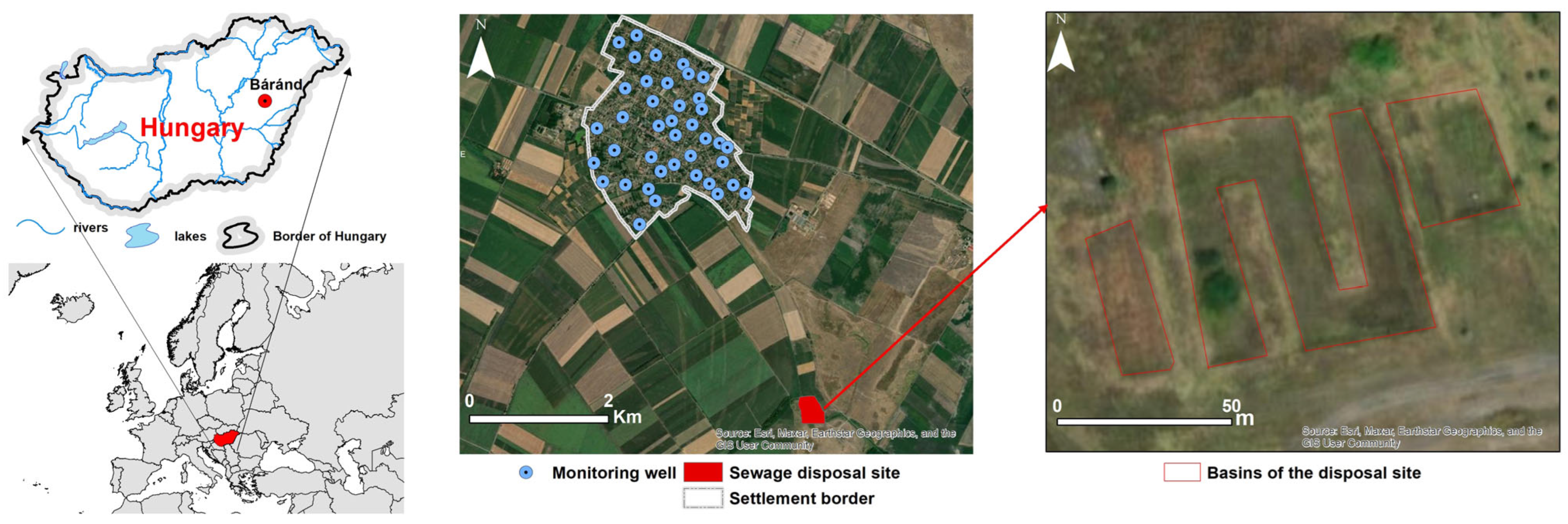
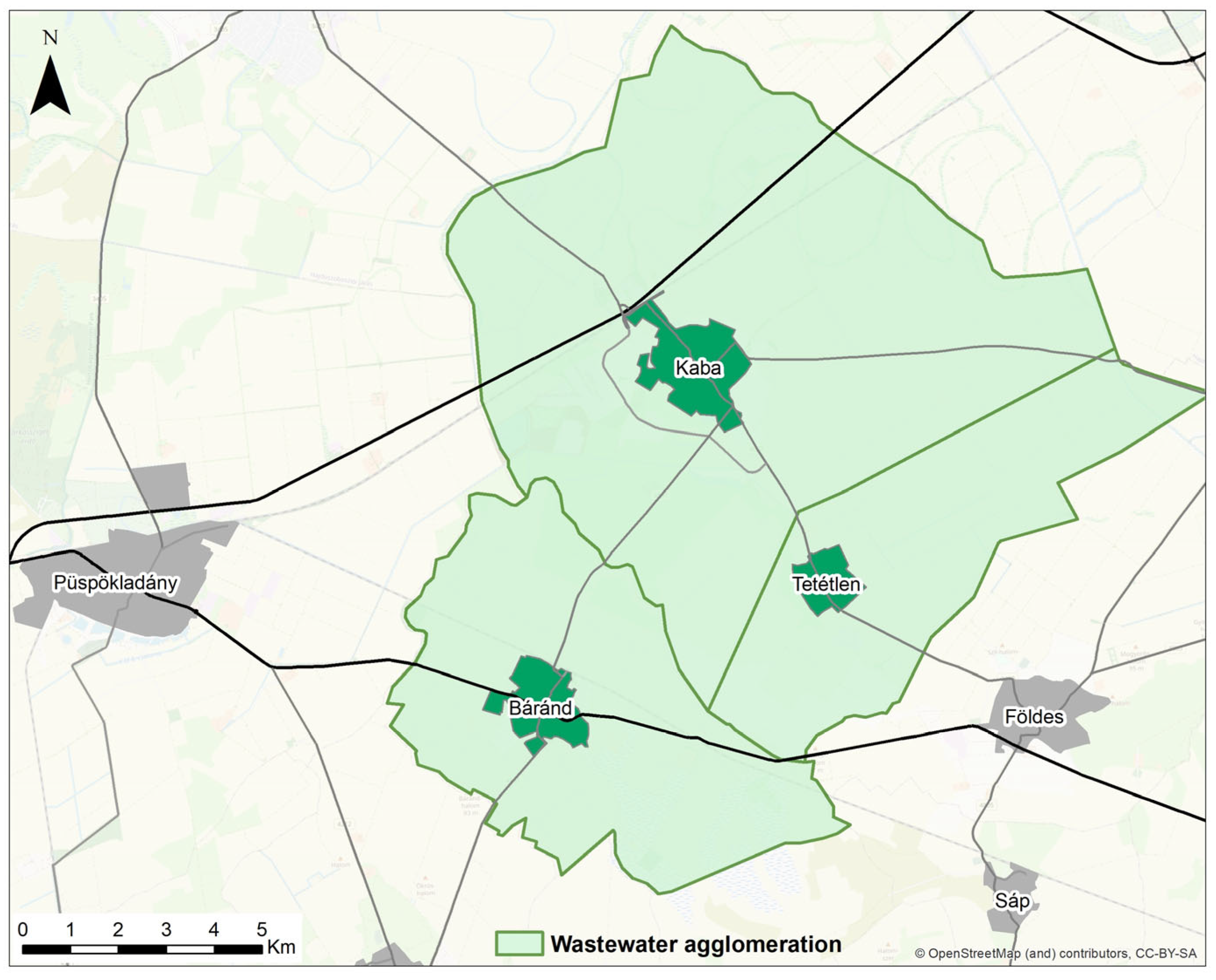



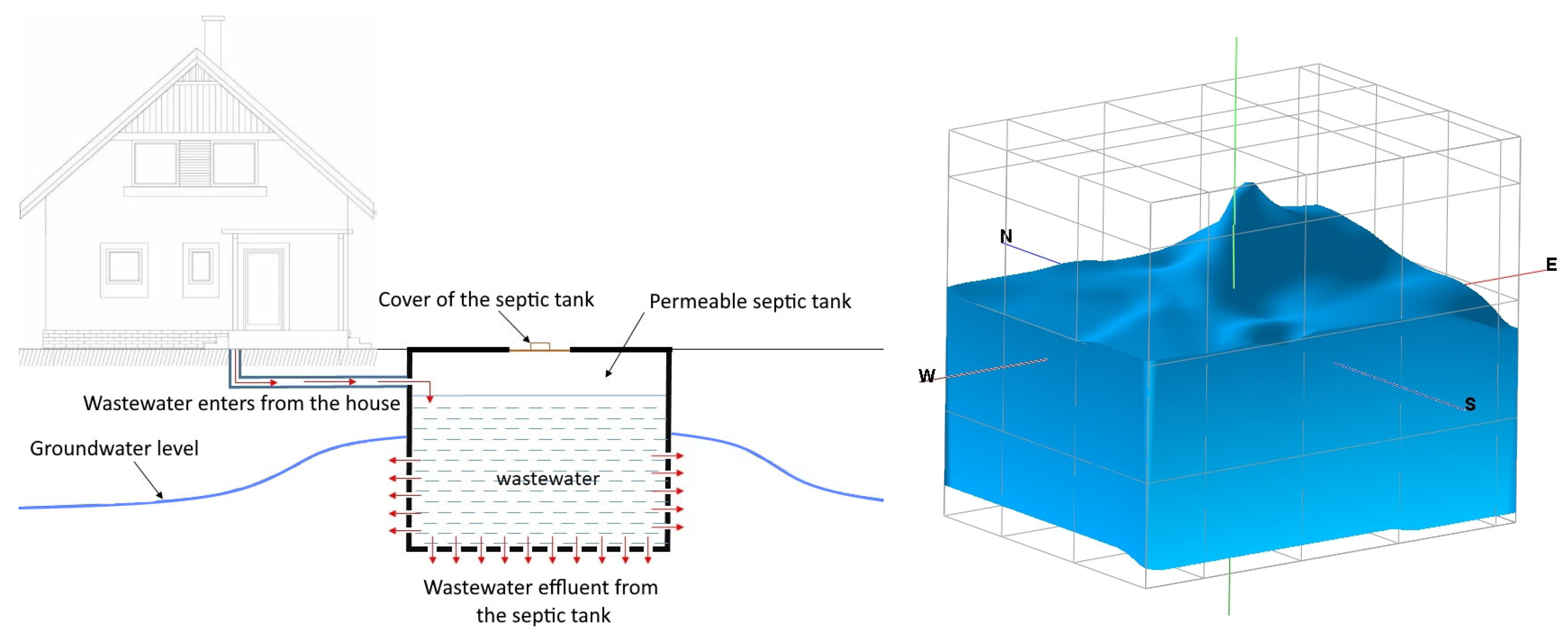


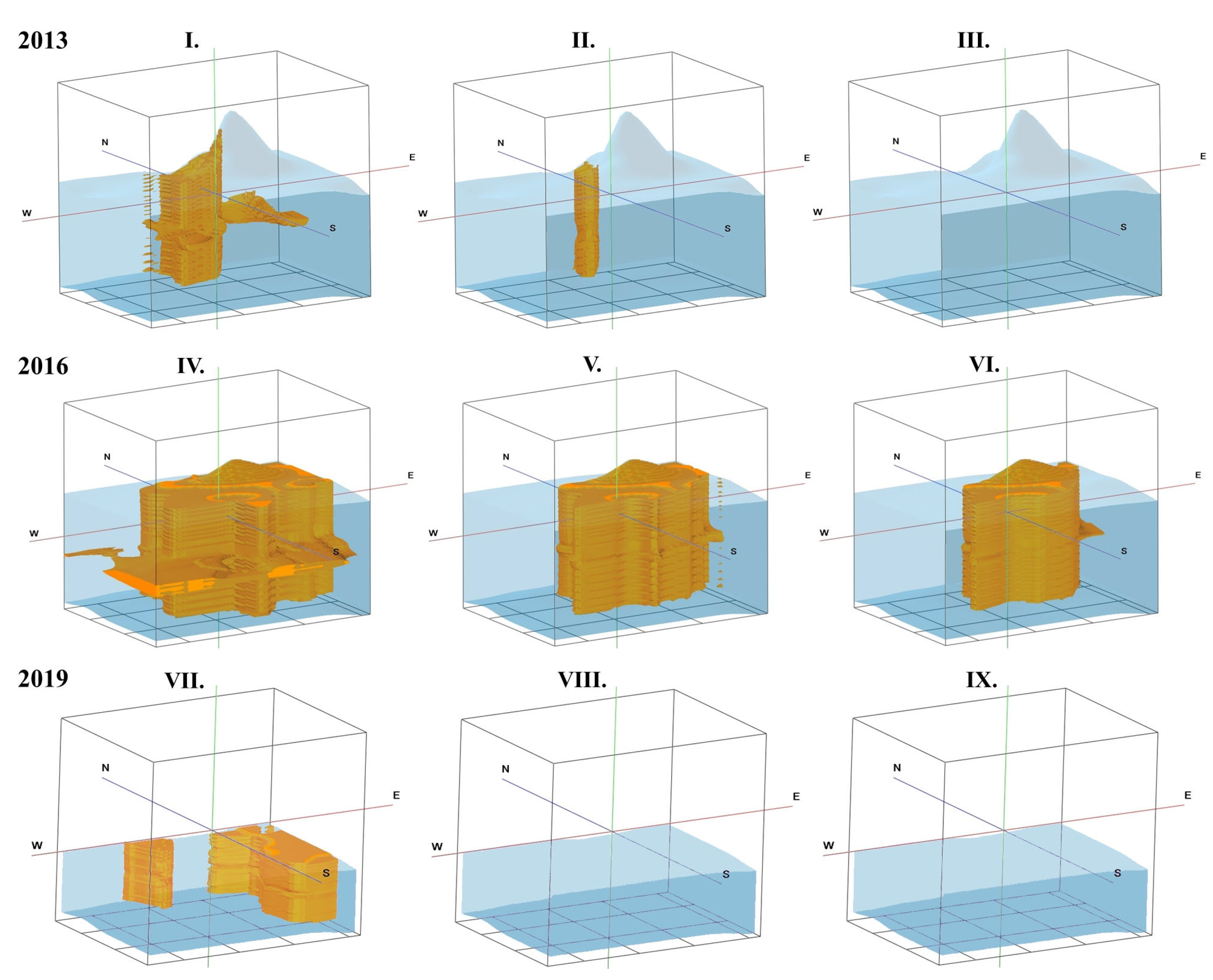


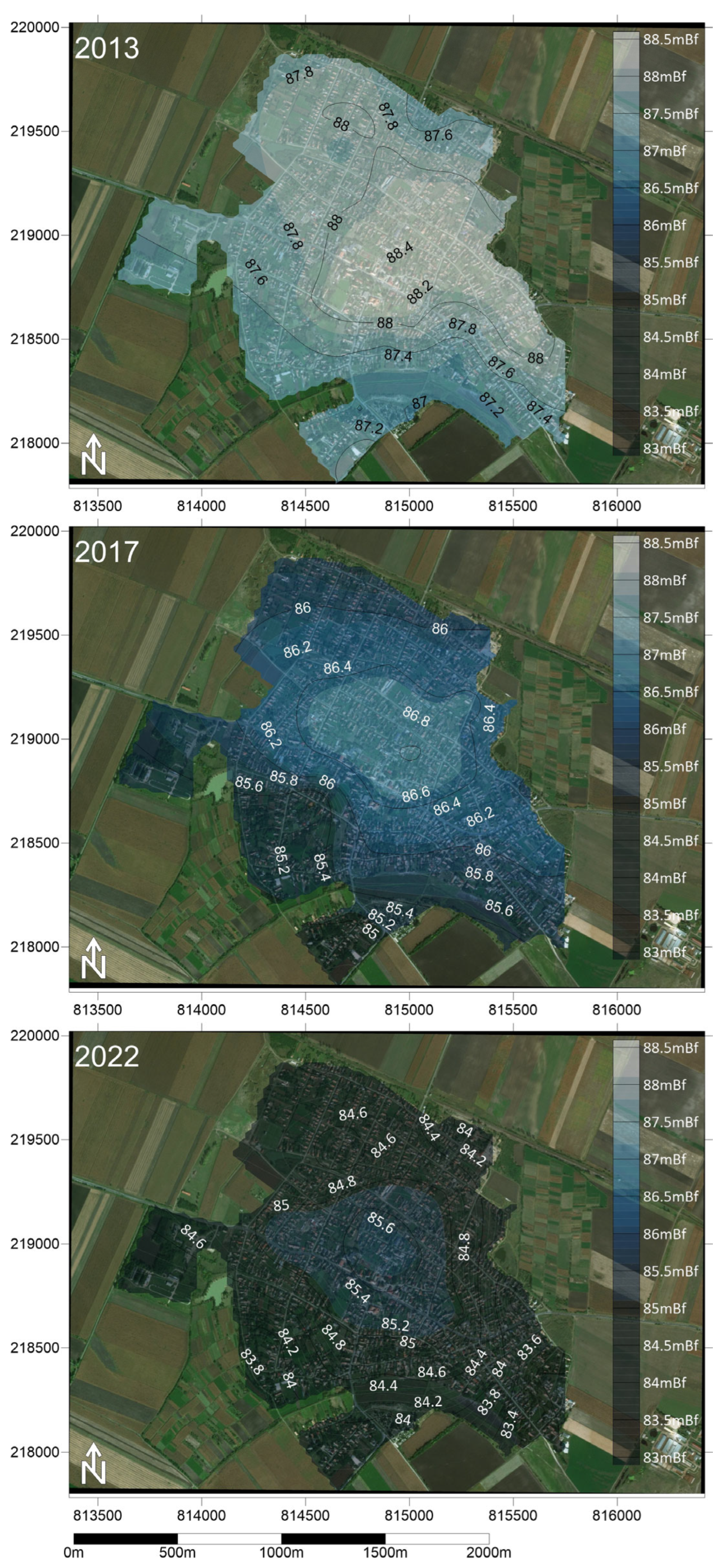
| Prior Sewerage | After Sewerage | ||||||||
|---|---|---|---|---|---|---|---|---|---|
| Well ID | Distance from the Septic Tank | NH4+ | NO2− | NO3− | Na+ | NH4+ | NO2− | NO3− | Na+ |
| (meter) | mg/L | mg/L | mg/L | mg/L | mg/L | mg/L | mg/L | mg/L | |
| BA1 | 1 m | 107.55 | 0.12 | 2.19 | 414.49 | 55.06 | 0.09 | 9.02 | 309.34 |
| BA2 | 5 m | 1.85 | 0.42 | 72.80 | 375.63 | 0.62 | 0.05 | 50.45 | 362.55 |
| BA3 | 9 m | 0.59 | 0.06 | 4.45 | 276.67 | 3.27 | 0.14 | 25.73 | 271.40 |
| BA4 | 15 m | 0.62 | 0.06 | 32.35 | 261.40 | 0.74 | 0.04 | 8.80 | 145.39 |
| BA5 | 15 m | 0.56 | 0.05 | 15.74 | 243.55 | 0.39 | 0.05 | 5.80 | 261.80 |
| BA6 | 1 m | 63.17 | 1.13 | 19.56 | 414.32 | 36.16 | 5.88 | 523.59 | 433.32 |
| BA7 | 8 m | 0.81 | 0.10 | 97.09 | 361.41 | 0.34 | 0.08 | 96.18 | 402.47 |
| BA8 | 13 m | 0.69 | 0.05 | 81.90 | 229.81 | 0.56 | 0.04 | 35.97 | 243.26 |
| BA9 | 10 m | 0.64 | 0.06 | 38.49 | 172.79 | 0.55 | 0.13 | 18.47 | 127.04 |
| BA10 | 25 m | 0.67 | 0.10 | 300.94 | 161.23 | 0.78 | 0.13 | 78.25 | 107.33 |
Disclaimer/Publisher’s Note: The statements, opinions and data contained in all publications are solely those of the individual author(s) and contributor(s) and not of MDPI and/or the editor(s). MDPI and/or the editor(s) disclaim responsibility for any injury to people or property resulting from any ideas, methods, instructions or products referred to in the content. |
© 2025 by the authors. Licensee MDPI, Basel, Switzerland. This article is an open access article distributed under the terms and conditions of the Creative Commons Attribution (CC BY) license (https://creativecommons.org/licenses/by/4.0/).
Share and Cite
Mester, T.; Szabó, G.; Kiss, E.; Balla, D. Towards Environmental Sustainability: Wastewater Management and Sewer Networks for Protecting Groundwater in Rural Settlements. Urban Sci. 2025, 9, 80. https://doi.org/10.3390/urbansci9030080
Mester T, Szabó G, Kiss E, Balla D. Towards Environmental Sustainability: Wastewater Management and Sewer Networks for Protecting Groundwater in Rural Settlements. Urban Science. 2025; 9(3):80. https://doi.org/10.3390/urbansci9030080
Chicago/Turabian StyleMester, Tamás, György Szabó, Emőke Kiss, and Dániel Balla. 2025. "Towards Environmental Sustainability: Wastewater Management and Sewer Networks for Protecting Groundwater in Rural Settlements" Urban Science 9, no. 3: 80. https://doi.org/10.3390/urbansci9030080
APA StyleMester, T., Szabó, G., Kiss, E., & Balla, D. (2025). Towards Environmental Sustainability: Wastewater Management and Sewer Networks for Protecting Groundwater in Rural Settlements. Urban Science, 9(3), 80. https://doi.org/10.3390/urbansci9030080








